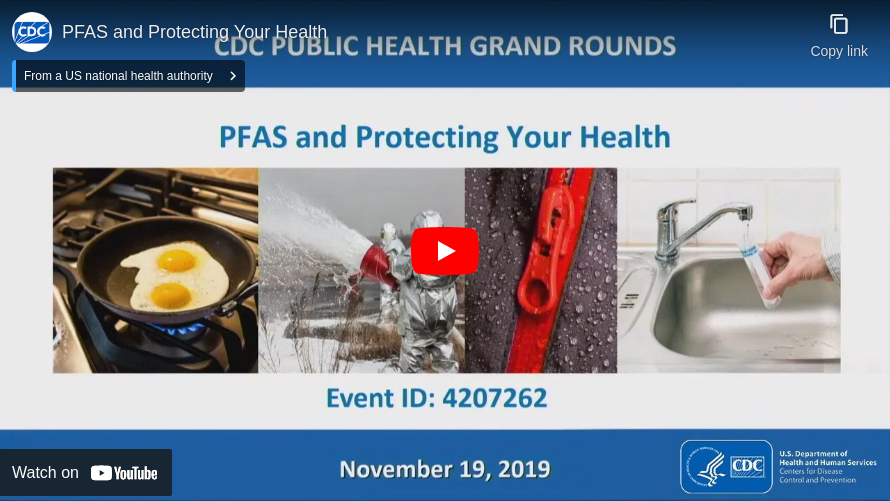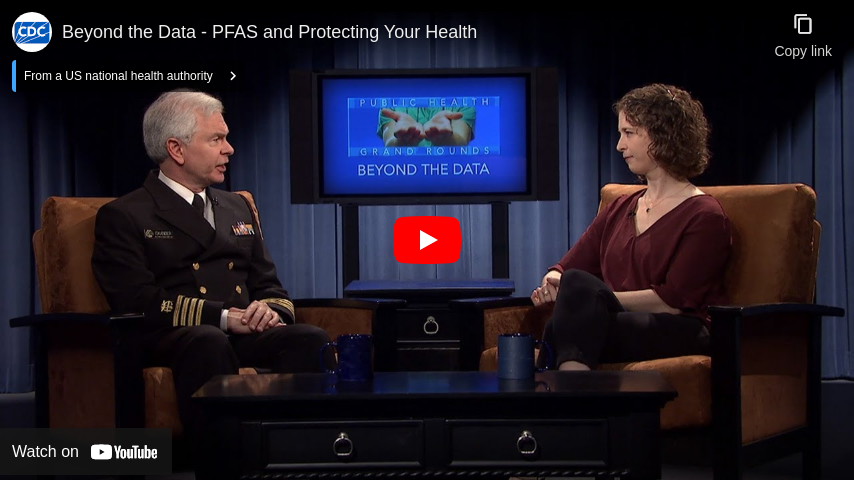PFAS and Protecting Your Health
Presented on .
The November session of Grand Rounds, “PFAS and Protecting Your Health,” was viewed in 3 foreign countries and 41 states, the District of Columbia, and the US Virgin Islands
Human exposure to PFAS (per- and polyfluoroalkyl substances) is a growing public health concern. PFAS are a large group of human-made chemicals that have been used in industry and consumer products worldwide since the 1950s. These chemicals are in food packaging and many other household products, and have been found in the air, soil, and water.
Studies suggest that exposure to PFAS may adversely affect a woman’s chance of getting pregnant and cholesterol levels and the risk of some forms of cancer. More research is needed to better understand the health effects of PFAS exposure.
This session of Public Health Grand Rounds will address current research needs and the many unknowns about PFAS. Presenters will discuss Michigan’s public health response efforts, a new CDC supported multi-site health study, and a community perspective on PFAS contamination.
What are PFAS chemicals and how are people exposed to them? How do they affect people’s health? Drs. John Iskander and Rachel Rogers discuss these questions and more. Learn what states and CDC are doing to determine PFAS exposure, the importance of community involvement, and what you can do if you think you’ve been exposed.
Can you speak more about the challenges to conducting clinical research on the reproductive effects of these chemicals? What sort of studies can clinicians and scientists do in affected communities?
1. Fecundity research (think time to pregnancy as a measure) is hard and relatively intrusive. Not that many people are motivated to participate, yet the studies require large numbers of participants. 2. Sperm morphology/number/activity research is also technically difficult. The ovaries and the eggs are accessible only with invasive technology. 3. The outcomes of interest in newborns can be affected by many aspects of study design that are hard to account for. An aside about that: The measures of outcomes such as "pondural index" (just one of the technical outcome measures) can find potentially important differences associated with exposure, but the public can be unaware of these technical measures and their potential importance for characterizing risk. 4. The most dread outcomes such as fetal death and birth defects and childhood cancer are blessedly rare, so that very large populations need to be followed. For the PFAS, there is some evidence of one type of birth defect outcome, but the size population (with a wide range of low to high exposures) needed to pursue this potential hint about risk is very a very large number of pregnancies. 5. An outcome that society really cares about is whether exposure affects the mental performance of the developing human. Lead is an example of an element for which we know this is a problem. Even for lead, which is today notorious for causing developmental performance problems, the original studies were fraught with controversy and critics. The studies are hard to do, and, even when they are done well, acknowledgment that the research is sound can still be withheld. 6. The reproductive/developmental research faces difficulties that also pertain to the rest of the PFAS science community: mixtures, the presence of evolving PFAS which are introduced by a creative industry but not announced to the public, and the difficulty of assessing exposure for the PFAS which have short half lives and are not bioaccumulative - but may still be toxic. Here is one difficulty that is truly a barrier. There is insufficient funding for the extra expenses associated with reproductive and developmental studies. Acquiring a critical mass of data when the funding is insufficient is a real challenge for the developmental research community.
- Rachel Rogers, PhD
- Environmental Health Scientist
Agency for Toxic Substances and Disease Registry, CDC
"The Science of PFAS: Knowns and Unknowns"
- Alan Ducatman, MD, MS
- Professor Emeritus
West Virginia University
"Human Health Effects of PFAS – The Intersection of Epidemiology and Community Concerns"
- Steve Sliver
- Executive Director
Michigan PFAS Action Response Team
Michigan Department of Environment, Great Lakes, and Energy
"How Michigan is Taking Action on PFAS"
- Andrea Amico
- Co-founder
Testing for Pease
"PFAS Contamination: Community Perspective"
- John Iskander, MD, MPH
- Scientific Director
- Phoebe Thorpe, MD, MPH
- Deputy Scientific Director
- Susan Laird, MSN, RN
- Communications Director
Get notified about the latest updates from Public Health Grand Rounds right in your inbox by setting up an alert today!
Get notified about the latest updates from Public Health Grand Rounds right in your inbox by setting up an alert today!Sign Up
Get notified about the latest updates from Public Health Grand Rounds right in your inbox by setting up an alert today!
- Presentation Slide Deck [PDF - 6 MB]
- https://www.atsdr.cdc.gov/pfas/index.html
- https://www.atsdr.cdc.gov/pfas/Pease-Study.html
- https://www.cdc.gov/biomonitoring/PFAS_FactSheet.html
- http://www.testingforpease.com
- PFAS and a Mother's Journey to Becoming A Clean Water Advocate | Andrea Amico | TEDxPortsmouth
- ATSDR PFAS Clinical Guidance
This session is available for Continuing Education (CE). Register here using the course information below.
CDC Course Code: PHGR10
CPE UAN: 0387-0000-19-011-H04-P
For more information, see Grand Rounds Continuing Education.


